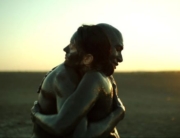The Art of Self-Defense is not a film that aspires to a straightforward, unfiltered depiction of reality. Instead, the style is intentionally a little off-kilter, and characters are likely to state their minds bluntly with a deadpan delivery. The karate school where much of the action takes place has a signboard that simply says “Karate,” and many stores and products are labeled with a similar tongue-in-cheek fashion. Bodies that have been beaten to a pulp are often disposed of with little difficulty, and their absence causes no stir. Director Riley Stearns clearly aims for the film to take place in its own heightened world, which he uses, very obviously, to explore and critique male behavior. As it turns out, neither the film’s style nor its substance is persuasive.
Casey (Jesse Eisenberg), a quiet, awkward bookkeeper, is beaten by a mob of motorcyclists on his way to buy dog food. Shaken and badly hurt, he signs up for a class at a karate school led by a tough, sinister sensei (Alessandro Nivola), who takes Casey under his wing. The culture of this school is one of testosterone and violence, though its one female student (Imogen Poots) regularly kicks everyone’s ass and is still given short shrift by the instructor. As Casey becomes more involved in the school and develops a deeper sense of validation from this subculture, he also becomes aware of the school’s dark underbelly when he joins the night class, forcing him to reevaluate his loyalty to sensei and decide how much wrongdoing is he willing to be complicit.
The actors are well suited to the material and accomplish what is asked of them with deftness and ease. They are equally adept at comic understatement and the outrageous extremes that the script demands of them. Many shots are framed deliberately and distinctively, and the film is expertly paced. Why Stearns’s vision fails to engage is not immediately easy to state then. One could say nothing about it rings true and that people don’t really behave this way, but why should I be moved by the deliberate unreality of Blue Velvet, The Night of the Hunter, and the many films by the Coen Brothers and Guy Maddin and be so repulsed by that of Riley Stearns?
The answer is that, ultimately, The Art of Self-Defense is not very smart. It’s built around a critique of toxic masculinity so obvious it could have been written by an algorithm. In fact, it seems to be one giant exercise to prove what it is: stated simply, a set of norms that promote violence, aggression, and emotional repression, harmful to both men and women. This gradual definition essentially forms the arc of Casey’s journey. As many of us are already well aware of what toxic masculinity is and what it can do, viewers will probably be deeply unsatisfied by this film.
It is worth noting that in Jane Campion’s Top of the Lake, we know everything The Art of Self-Defense claims to teach us about men within 30 seconds of Peter Mullan’s character opening his mouth. Toxic masculinity was not a buzz-term yet when Elaine May made 1976’s Mikey and Nicky, but her film contains a far deeper exploration of the emotional lives of troublesome men and the levels of wrongdoing they are willing to take part in. Kiss Me Deadly (1955), also made long before the term was used, simply has a toxic man as its protagonist and follows him as he destroys everything in his path. These films incorporate an understanding of a certain type of masculinity and then go further, as opposed to simply trying to define it.
If an artist chooses the right subject at the right time, the film is more likely to get made, the book to be published, the play to receive a production, regardless of whether the artist’s take on the subject is actually adding anything to the discourse. When it comes to politics in art, the bar should be much, much higher. The arts should do something for us that the news simply can’t, and toxic masculinity is something that is clearly defined for us every time we go on the internet or when the president appears on our TV screens. We demand of our journalists that they give us intelligent commentary, and we must demand the same of our artists, as opposed to simply applauding them for choosing to broach an important subject. I don’t know how much applause is waiting for The Art of Self-Defense, but my guess is that it is likely to leave many viewers hungry for a deeper film.







Leave A Comment